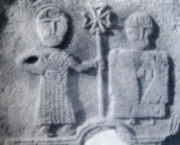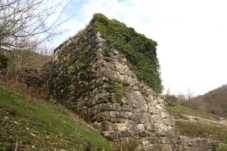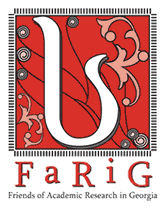Research Reports
17th-century Georgian-Persian Documents
Digitized Examples of the 17th-century Georgian-Persian Illuminated Historical Documents from Georgian Repositories
A recent publication by Elene Giunashvili
Available on The Digital Orientalist.
The Origin of the Trust
A Comparative Linguistics and Law Perspective
Irina Gvelesiani takes an interdisciplinary approach, showcasing the interconnectedness of law and language, shedding new light on the origin of trust law.
Available on springer.com.
Memories from the Detached Lands
Soviet Forceful Resettlement Policy in the Eyes of the Chechens, Ingush and Khevsurs (1940 –50s)
A paper by Anna Tchintcharauli, co-winner of the Griboyedov Grant 2024
Available on degruyter.com.
Ancient Georgia and pre-Islamic Iran
Issues of Cultural Relations in the Light of Glyptic Data
A paper by Ketevan Ramishvili (Georgian National Museum) Helen Giunashvili (Ilia State University).
Follow links to:
Legal Capacity of Minors
Being a child on the threshold of the third millennium:
perspectives for the protection of the child's personality development.
Giorgi Amiranashvili received a small grant to enable him to present his paper Legal Capacity of Minors and Validity of Transactions Made by Them at the International Conference in Rome on 20th - 21st November 2023.
Urban Archaeology in Tbilisi
Tatia Butsuradze presented her paper on Urban Archaeology in Tbilisi at the CHNT28 Icomos conference in Vienna on 16th November 2023 during the PhD/Master Session.
You may also view the Abstract .
The Digital Orientalist
Follow the link below for a post by Elene Giunashvil, guest contributor for Iranian Studies for 22-23.
Persian Illuminated Historical Documents of Safavid Period from Georgian Depositories.
Georgian Medieval Church Bell
Bells of different sizes and functions have been made in Georgia since ancient times; During archaeological excavations were found small ritual as well as jewelry bells that existed before Christianity. The oldest bells found in Georgia date back to the 7th century BC.
Read the Full Document.
The Persian Gospel Manuscript in Georgian Script
Notes on the Persian Gospel Manuscript in Georgian Script by
Helen Giunashvili, Research Associate, Giorgi Tsereteli Institute of Oriental Studies, Ilia State University
Tamar Abuladze, Head, Department of Manuscript Preservation and Registration, Korneli Kekelidze Georgian National Centre of Manuscripts
Heroes as Narrators in Georgian Folk Tales
Dr Elene Gogiashvili from Tbilisi State University presented the attached slides in the section Folktales Characters and Emotions of the 18th Congress of the International Society for Folk Narrative Research held online on September 5-8, 2021
Her paper gives an account of the Georgian folk tales describing cross–periodical heroic past. Three epic heroes – Amiran, Tariel and Rostom, discussed in this article, are the most popular figures in Georgian narrative tradition, introduced through literature and subject to a number of interpretations in folklore, in line with patterns common in folk narratives. The paper examines the archival material of the three heroes’ tales, recorded in the late 19th to 20th centuries in Georgia, presenting at once Amiran, Tariel and Rostom as narrators. They tell their own adventures. Amiran is a mythological hero, chained in a cave in the mountains of the Caucasus. Tariel is a protagonist of the poem “The Knight in the Panther’s Skin” by Shota Rustaveli, Georgian writer of the twelfth century. Rostom is a Georgian, transformed name of Rostam, a character of the poem “Shahnameh” by Firdawsi, Persian writer of the eleventh century. Each of these heroes possesses their own cycle of tales in Georgian oral tradition. As notions of time and narrative changed, these figures displayed the very ideas that its audience was dealing with in the real world outside of the frame. There are put together very favourite characters for Georgians. Amiran, Tariel and Rostom – through a frame tale – affirm these new ideas while, at the same time, open a window back to the familiar world of traditional narrative.
Download the slideshow.
The Role of Late Antique Silverware from Royal Necropolis
Lana Chologauri, 2020
The Role of Late Antique Silverware from Royal Necropolis in Studying the Social and Political Background in Caucasian Iberia is a short discussion about relations between the kingdom of Iberia (East Georgia) and the surrounding empires in late antiquity.
The Edinburgh Conference on Late Antiquity for Postgraduates and Early Career Researchers
April 21-22, 2016 - organised by the University of Edinburgh.
"Reinforcing Eastern Limes: Fortifications of Lazica in the Age of Justinian I". A lucid and succinct archaeological report on an important aspect of the Roman-Byzantine period in Western Georgia presented by Natia Natsvlishvili. You can download the Paper and Presentation.
2013 FaRiG Research Grant
The 2013 FaRiG research grant went to Natalia Chitishvili. Her project concerned "The liturgical planning of medieval Georgian churches with a particular focus on the tradition of allotting special places for different ranks of clergy and laity". You can now download Natalia's final report:
KING’S AND QUEEN’S PLACE IN THE INTERIOR OF THE GEORGIAN CHURCH
Translations from Georgian into English
Anna Chelidze, 2012
A study by the Next Page Foundation in the framework of the Book Platform project
3rd International Septuaginta Summer School
The 2012 summer school was organized by the Septuaginta-Unternehmen of the Academy of Sciences and Humanities of Göttingen. You can read a report by Natia Mirotadze
Georgian secular depiction between Sassanian and Byzantine prototypes

Quarterly Report For FaRiG Rothschild Research Grant
Leri Tavadze
The first quarter lasts from March up to the end of May. Initial goal for the first quarter was to collect the materials concerning the research topic as well as arrangement of presentation of my project at Ivane Javakhishvili Tbilisi State University also wherever it is possible, namely at scientific research conferences.
The Fortification System of Lazika Kingdom
The Fortification system of Lazika (Egrisi) kingdom in the 4th-6th centuries (Research into West Georgian Castles)
Nikoloz Murghulia
 The main aim of the scientific survey project was the complex investigation of castles situated in West Georgia. As a result Nikoloz Murghulia visited and recorded 45 sites in West Georgia during March, April and May 2010.
The main aim of the scientific survey project was the complex investigation of castles situated in West Georgia. As a result Nikoloz Murghulia visited and recorded 45 sites in West Georgia during March, April and May 2010.
The Battlefield between East and West
A History of Georgia as reflected by the town of Gori
Irene Giviashvili
This lecture was presented at The British Institute at Ankara (BIAA) on 4th March 2010 by Irene Giviashvili.
The Woman in Western and Georgian Literature of the Middle Ages
Nino Chakunashvili, 2009
This research discusses certain characteristics of Western romances of the Middle Ages and of "The Knight in the Panther Skin": ideal-thematic motifs and structural elements, typological parallels and the individualisation of characters. It looks at one question, which is the point of view of the woman in Western and Georgian literature of the Middle Ages.
The Woman in Western and Georgian Literature of the Middle Ages.
The Alaverdi Eparchy
Eka Kacharava
From the second half of the 16th century to the beginning of the 17th century Alaverdi, the main spiritual centre of the Kingdom of Kakheti, flourished. The situation changed drastically at the turn of the 17th century, when the life of the Alaverdi eparchy was defined completely by the political developments occurring in the country.
This research is presented as two works:
The Architecture of Tbilisi
Nineteenth-Century Architecture of Tbilisi as a Reflection of Cultural and Social History
Nino Chanishvili
The city of Tbilisi underwent incredibly rapid development in the 19th century. From a feudal town, it grew into one of the most important metropolises of the Russian Empire and became the major political, administrative and cultural center of the South Caucasus. The present article purports to explain how the social and the cultural context of Tbilisi reverberated on the face of the city.
Nino Chanishvili has visited four sites. As well as the main study into The Architecture of Tbilisi, she has also written reports on the architecture of Salonica, Sarajevo and Baku.
Illuminated Gospels
The Georgian Scriptoria of the Black Mountain (Antioch): Illustrations of the Gospel Books
Nino Kavtaria
My project, supported by a FaRiG Grant, researched the illuminated Gospel manuscripts from the Georgian scriptoria of the Black Mountain near Antioch (now in Turkey).
The Georgian codices from these Scriptoria of the Black Mountain collectively form the most significant group of Georgian miniature paintings. They not only illustrate the text, but also depict the cultural and political context in which the handwritten book was produced.
Art Nouveau
Nestan Tatarashvili
Art Nouveau is an international style of art, architecture and design that pekaed in popularity at the beginning of the 20th century (1880-1914) and is characterised by highly-stylised, flowing, curvilinear designs often incorporating floral and other plant-inspired motifs. The Art Nouveau Preservation Group of Georgia has been led for many years by Nestan Tatarashvili, architect.
Georgian Icon Painting, 1600-1830
Mzia Janjalia and Nana Kuprashvili
This is the first exploration of an unknown subject - the Georgian icons of the two centuries leading up to the mid-nineteeth century. Our work enabled us to understand some of the ways in which Georgian artists appropriated some western European models. Hitherto it had been the general belief that all the links came through Russia. But Georgia and Europe were far more directly connected.
Georgian Literature
Early Modern Georgian Literature and its Social and Cultural Implications
Marina Alexidze
The project has followed from the growing interest in the roots of Modernity in Georgia. The conducted research aims at contributing to the better understanding of the initial stage of the development of Georgian culture on the common European way. Besides, study of the Early Modern Georgian literature gives a good chance to trace the emergence and early development of the Modernity in non-Western cultures - the aspects, which became particularly important in the last decades.
Secular Tendencies
Secular Tendencies in the 13th Century Murals of the Age of Queen Tamar
Maka Bulia
The decoration of the main church seems to be the most important of the surviving paintings at Natlismtsemeli Monastery. Fragments dating from various periods appear to convey the entire history of the monastery and its artistic creativity.
Nokalakevi
The Anglo-Georgian Expedition to Nokalakevi (AGEN)
FaRiG supports AGEN’s work at the village of Nokalakevi in Mingrelia, western Georgia.
Pichvnari - Excavation Report
Michael Vickers and Amiran Kakhidze
 The eleventh season of the joint British-Georgian Pichvnari Expedition, organised on the Georgian side from the Batumi Archaeological Museum and the Batumi Research Institute, and on the British from the Ashmolean Museum, Oxford took place between mid-July and mid-August 2008. This year was unusually exciting, since hostilities between Russia and Georgia broke out during the last few days of our season. Both the personnel and the site escaped unscathed. Most ‘British’ students left via Turkey on instructions from the embassy.
The eleventh season of the joint British-Georgian Pichvnari Expedition, organised on the Georgian side from the Batumi Archaeological Museum and the Batumi Research Institute, and on the British from the Ashmolean Museum, Oxford took place between mid-July and mid-August 2008. This year was unusually exciting, since hostilities between Russia and Georgia broke out during the last few days of our season. Both the personnel and the site escaped unscathed. Most ‘British’ students left via Turkey on instructions from the embassy.
The Blessed Theodoret of Cyrus
Victoria Jugeli
Report
The research is published as: The Blessed Theodoret of Cyrus: the life, activities, creed, writings and their Georgian translations. Vol. I. Tbilisi: Logos, 2008, Victoria Jugeli. You can view a summary as a PDF.
Images
The following images of the manuscripts' folia represent the illustrations of the edition. These manuscripts are preserved in the National Centre of Manuscripts, Tbilisi, Georgia.




